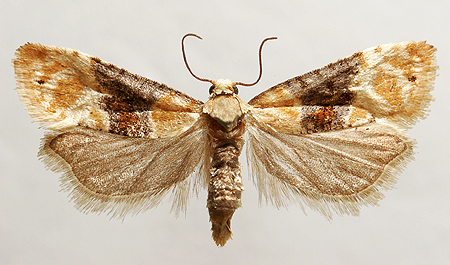Pests
Eupoecilia ambiguella (Hubner) - European Grape Berry Moth, Grape Berry Moth, Grape Bud Moth, Vine Moth, Grape Moth
Systematic position.
Class Insecta, order Lepidoptera, family Tortricidae, subfamily Tortricinae, genus Eupoecilia.Synonyms.
Clysia (Cochylis) ambiguella Hbn.Biological group.
This species is a pest of grapes.Morphology and biology.
The wingspan of this species is 14-18 mm in adults. Fore wings pinkish-yellow, with a black transversal trapezoidal stripe in the middle. Larvae are light gray, later dark red or pinkish. Head and occipital scutum black. Length reaches 14 mm. Develops in two generations, in Central Asia a third generation also occurs. Diapausing pupae over-winter in dense cocoons under exfoliating bark, in crevices and cracks of stalk. The lower threshold of development is about 7°C. At 11-12°C over-wintered pupae need 40-45 days and sum of effective temperatures about 180°C for their development. In the Ukraine and Moldova moth flight occurs usually in the last third of May. Duration of egg development is 13 days at 15°C, 6-7 days at 19-25°C. Female lays up to 100 eggs. Development of 1st generation larvae lasts 15-25 days. On the average, development of summer generation continues for 47 days. At the end of August the larvae leave their feeding places and spin cocoons, where they pupate and over-winter. The autumn pupation begins at the end of September or in the beginning of October, lasting for some weeks. Flight of over-wintered adults occurs in May (Moldova) or at the end of May and in June (Primorskii Territory); the flight of first generation moths occurs in the last third of June or in July (Moldova) and from the end of June until the beginning of September (Primorskii Territory).Distribution.
In the territory of the former USSR the species is distributed in the European part northward to Petrozavodsk, in Transcaucasia, Kazakhstan, Central Asia, south Siberia, Amur Region, Primorskii Territory, Sakhalin and south Kuriles. It is known from Western Europe (northward to Finland and westward to southeast England and southern Wales), Asia Minor, Iran, China, Korea, and Japan.Ecology.
The egg-laying period for the over-wintered females usually coincides with the inflorescence status of grapes. Female lays eggs one by one on buds, bracts and anthophores, less often on young sprouts. First generation larvae eat flower buds, gnaw anthophores, eat buds and flowers, densely covering them with a web. If an inflorescence has 3-4 webs, it will be completely destroyed. Pupation occurs among the dried residues of damaged inflorescence or outside feeding places, i.e., on leaves, sprouts, bark of stalks. Second generation moths lay eggs on immature berries of grapes. Larvae gnaw out round holes and penetrate into berries, eating away pulp and unripe seeds before they harden. One larva is able to damage 9-12 berries on the average. The residues of damaged berries dry up, like raisins, growing moldy in rainy weather. Larvae are polyphages, they damage fruits of buckthorn, viburnum, ivy, lilac, honeysuckle, Cornelian cherries, maple, and other arboreous and fruticose plants in addition to grapes. The European Grape Berry Moth development is strongly influenced by air humidity; adult fecundity sharply decreases in low relative humidity (30-40%) and at temperatures of 30-32°C; the majority of laid eggs perish. Levels of 70-90% RH and air temperature 18-25°C are the most favorable for insect development.Economic significance.
The pest causes harm to grapes and Schizandra. One larvae of the first generation can destroy up to 30 buds and one larvae of the second generation can destroy up to 17 grape berries. Control measures are the same as those for Lobesia botrana.Reference citations:
Aliev A.G., Bashirov F.B., Blagonravov P.P., Gukasov A.I., Zakharova E.I., Kolesnik L.V., Komarova E.S., Korneichuk V.D., Krupennikov A.M., Kuzmin A.J., Lazaryan V.M., Lukyanov A.D., Makarov-Kozhukhov L.N., Makarov I.F., Makarov S.N., Malkhasyan M.A., Mesyatseva L.V., Mishurenko A.G., Natsvin A.V., Negrul A.M., Oleinik L.F., Palamarchuk G.D., Panamarchuk V.I., Pirusskii V.V., Ruzaev K.S., Saburov N.V., Skuin K.P., Solovev A.K., Sosina E.I., Tabidze D.I., Turyanskii G.F., Tseitlin M.G. 1959. Book for wine grower. Moscow: State Publishing House Agric. lit. 626 p. (In Russian)Dobrodeev A.I. 1915. Grape leaf rollers, the European grape berry moth (Clysia [Cochylis] ambiguella Huebn.) and grape moth (Polychrosis botrana Schiff.) and measures of their control according with the newest researches. Proc. Bureau on entomology of Scientific Committee Agriculture 11(5): 37. (In Russian)
Ivannikov A.I. 1968. The European grape berry moth in Kazakhstan. Russian J. of Horticulture 6: 28. (In Russian)
Kuznetsov V.I., ed. 1994. Insects and mites - pests of agricultural plants. V. 3(1). Lepidoptera. St. Petersburg: Nauka. 316 p. (In Russian)
Plugaru S.G. 1971. On fauna and ecology of leaf rollers (Lepidoptera, Tortricidae) of Moldova. Harmful insects of Moldova. Kishinev: Institute of zoology Acad. Sci. Mold. SSR. 3-31 p. (In Russian)
Schmidt K., Hoppmann D., Holst H., Berkelmann-Lohnertz B. 2003. Identifying weather-related covariates controlling grape berry moth dynamics. Bull. OEPP., 33: 517-524.
Seryi N.I. 1971. Entomofauna of grapevine in Moldova. Harmful insects of Moldova. Kishinev: Institute of zoology Acad. Sci. Mold. SSR. 87-107 p. (In Russian)
Shchegolev V.N. 1960. Agricultural entomology. Moscow-Leningrad: State Publishing House Agric. lit. 448 p. (In Russian)
Shreiner Ya.F. 1906. The European grape berry moth and its economic significance for wine growing. J. Winemaking News. Odessa. N. 2: 82-87, N. 3: 140-146, N 4: 205-210. (In Russian)
Silant.ev A.A. 1911. Grape leaf rollers. Odessa, Library of J. Winemaking News 12: 44. (In Russian)
Vasil.ev V.P., ed. 1973. The pests of agricultural crops and forest plantations. V. 2. Kiev: Urozhai. 606 p. (In Russian)
Zverezomb-Zubovskii E.V. 1948. The European grape berry moth (Clysia ambiguella Hb.). Pests of Agricultural Plants. Issue 32. Kiev-Odessa. 3 p. (In Ukrainian)


